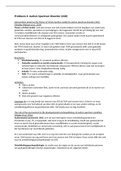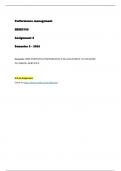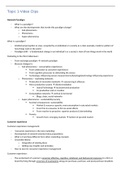Make the case (or not) for ‘optimal diversification’ (across different lines) in at most two pages.
At least half of the answer should cover discuss the value of alternative assets.
Diversification is highly important as a portfolio building block. The investor can diversify across many
stocks, internationally (including emerging and frontier markets), and across alternative asset classes.
First, the investor should focus on diversifying across stocks. Portfolios with large amounts of
idiosyncratic risk are inefficient, as you will only be compensated for the systematic risk. If the portfolio
is not well-diversified, the portfolio will yield a certain return for a too high level of risk. Put differently,
the portfolio could yield the same return by bearing less risk if it would be well-diversified. Earlier
studies stated that you need around 20 stocks to diversify away the idiosyncratic risk, whereas later
studies show that you need around 50 stocks to have a well-diversified portfolio. As 50 stocks are way
too many stocks to pick for an individual, individuals might benefit from buying for instance index-
trackers (ETF).
However, diversifying between stocks within the same country may be suboptimal for two main reasons:
1. All stocks within a country are exposed to the same local economic shocks (still: home bias)
2. Local index may be concentrated in limited number of industries
3. Only indirect diversification through multinationals
If you diversify internationally, country-specific shocks are diversified away. However, to what extend
are there still benefits from international diversification? Evidence shows that the benefits from
diversification across developed markets remain, but is not huge. The volatility declines if you move
from investing in one country to investing in five countries, but beyond five countries there are no real
international diversification benefits anymore. The explanation is that developed countries have become
so correlated, that benefits of international diversification have disappeared. The explanations for
increased correlation across international markets are (1) economic integration, and (2) financial
integration. Economic integration argument states that economies have become more and more
economically interlinked, and hence also firms’ cash flows have become more interlinked. As firms
trade internationally, their cash flows will depend on the global cycle (and no longer depend on the
idiosyncratic national cycle). Hence, the dependence on the global cycle makes firms’ cash flows
correlated. Second, the financial integration argument states that cross-country cash flows are
discounted at the same global discount rate, set by a global representative investor, rather than at a local
discount rate. All that matters for the global investor is the global economy (and not the national
economy). This leads to discounting cash flows at one discount rate (irrespective of the national discount
rate). The effect of financial integration (discount rate) is stronger than that of economic integration
(cash flows). In conclusion, globalization of the economy and financial markets has resulted in within-
region correlation. Often correlations across equity markets are 85 – 90 percent. Ideally, however,
correlations need to be below 50 percent to really have an international diversification effect.
We can, however, diversify internationally by including emerging and frontier markets in the portfolio.
The efficient frontier of a portfolio including emerging markets and frontier markets lies above the
efficient frontier excluding those markets. This indicates that one can harvest higher return at the same
risk by including emerging and frontier markets in the portfolio. Emerging and frontier markets are not
interesting in terms of high expected growth (as high growth will possibly be already incorporated in
the share price), but they are interesting because they allow additional diversification at modest risk,
and allow additional risk premium (political risk, liquidity risk). The discount rates to value shares
incorporates the risk-free rate and a risk premium. If the market is illiquid, we will increase the discount
rate with a liquidity risk premium and discount the cash flows at the higher discount rate (leading to
1
,lower value). The same applies to political risk. The value of the shares in these markets will increase
when political risk is slightly disappearing (leading to a lower discount rate and higher share price).
Investing in those markets is thus betting on risk premium. A final note is that correlation of frontier
markets also seem to be rapidly rising, causing the potential benefits of international diversification
using frontier markets to diminish over time.
Finally, we can diversify across alternative asset classes. Examples of alternative asset classes are hedge
funds, private equity, gold, commodities, and inflation-protected bonds. First, hedge funds. The assets
under management of hedge funds have increased over 1995 – 2015, though we should be sceptical
about hedge funds as their returns have declined steadily over this period. Maybe the initial high returns
of hedge funds has attracted so much money, that there is more money than good ideas. Moreover,
despite hedge funds can short the market, they lost lots of money during the crisis (less than the 60/40
strategy, but still lost lot of money). After the crisis, hedge funds seem to be far too defensive, resulting
in a performance far below the market performance. Furthermore, hedge fund returns before the crisis
were 55% correlated with the 60/40 strategy, whereas after the crisis hedge fund returns were 79%
correlated with the 60/40 portfolio (low diversification benefit). Finally, the average hedge fund loses
more than 4% during flights to safety, whereas the average market portfolio loses 2% during flights to
safety. Second, we can look at private equity. Individuals are likely to invest in a private equity fund,
which are rather illiquid investments. Private equity funds need to report the value of the assets under
management on a monthly basis. However, the performance and volatility of these funds is difficult to
measure (and hence easy to manipulate). Most researches show that PE does not outperform listed
equity. The third alternative asset class is gold. Gold did very well over the last 15 years, but gold does
not pay a dividend or interest (so it costs you money in terms of storage costs and transaction costs).
The two prominent perceived qualities of gold is that (1) gold is an inflation hedge, and (2) gold provides
a hedge against bad times. If gold were a good inflation hedge, then its real value should be constant
over time (known as the golden constant). Historical data shows, however, that there is no positive
relationship between unexpected inflation and the change in gold price. At best, there might be a
relationship between the gold price and long-term inflation. Second, gold is not the best hedge against
bad times. Only in 20% of the observations, the monthly total return of gold is positive when the monthly
total return of the S&P500 is negative. Fourth, we can add commodities. Two popular perceived reasons
to include commodities in strategic portfolios are (1) commodities provide a hedge against inflation (as
commodities are part of inflation), and (2) commodities are good portfolio diversifiers. The critiques on
commodities are that it is far from clear that commodities provide a hedge against inflation (at least no
perfect hedge). Moreover, correlation with equities has increased over time, reducing the diversification
effect. Currently, commodities are an attractive hedge against inflation (low correlation with S&P500).
Finally, a great diversifier in portfolios are bonds. Since the end of the 1990s, treasury bonds have
offered a great possibility to hedge against inflation. Treasury bonds offer a premium over T-bills, have
low correlation with stocks, and go up in value in crises. If we look over the long-term, combining stocks
and bonds in a portfolio is a clever strategy. The Sharpe ratio of a 60/40-portfolio exceeds the Sharpe
ratio of a portfolio including only stocks. Put differently, the risk-adjusted return of the 60/40 portfolio
is more attractive. A particular type of bonds that can be included in the portfolio are inflation-protected
bonds (TIPS). TIPS are attractive because (1) they offer high expected return and low risk relative to
bonds, (2) they have low correlation with other asset classes, and (3) they have low volatility. A nominal
bond loses when inflation increases, while an inflation-protected bond will not react to inflation. The
notional amount of inflation-protected bonds increases with inflation, ensuring a fixed real coupon rate
and principal amount that will not change with inflation. Whereas commodities and gold are imperfect
hedges against inflation, inflation-protected bonds are a perfect hedge against inflation.
2
, In conclusion, the optimal diversification is an interesting topic. Investors should diversify to obtain the
best risk-return trade-off. Investors obtain large diversification opportunities from diversifying across
many stocks, as idiosyncratic risk is diversified away. International diversification should lead to
additional diversification benefits. However, the diversification benefits of investing in developed
countries is low due to the globalization of the economy and the corresponding increased correlation of
financial markets. However, investors will yield higher returns at the same risk by including emerging
and frontier markets into their portfolio. Finally, investors can diversify by investing in alternative asset
classes. TIPS are considered to be the best alternative asset class when an investor expects inflation.
Moreover, commodities are good portfolio diversifiers.
What is Equity under-participation and why is it a puzzle?
Equity offers a premium over bonds because the equities are riskier. Despite the premium on equity,
(historical) data shows that people under-participate in the equity market. Around 50 percent of the US
households with positive wealth do not hold stocks. In Europe, the percentage of householders that do
not hold stocks is even larger. Equity under-participation indicates that a large number of people with
positive wealth do not hold stocks and it is unclear why, as equities offer a premium to compensate for
their riskiness.
The equity premium puzzle (EPP) is a phenomenon that describes the anomalously higher historical real
returns of stocks over bond. The equity premium, which is defined as equity returns minus bond returns,
has been approximately 5.5%. The premium is supposed to reflect the relative risk of stocks compared
to bonds, but the puzzle arises because this unexpectedly large percentage implies an unreasonably high
level of risk aversion among investors.
There are several explanations named for equity under-participation:
1. People are too risk averse to invest in equities
2. High volatility of equities
3. (Myopic) loss aversion
4. Probability overweighting
5. Ambiguity aversion
The argument that people are too risk averse to invest in equities is invalid. The risk-aversion level
ranges from 1 to 10, with 10 indicating that people are so risk-averse that one does not want to come
out of the house. The mean-variance optimization for a risk-aversion level of 10 shows that the allocation
to equity in this extreme case is 20%. In conclusion, even for unrealistically high risk aversion levels,
we still get a 20% allocation to equities. Put differently, even people with unrealistically high risk
aversion levels are expected to allocate part of their wealth to equities.
The high volatility of equities is an invalid argument for equity under-participation from a conventional
perspective. The stocks usually have a volatility of around 20%, resulting in a 5 percent VaR of 1.65 *
20% = 33%. This implies that in 5% of the cases, you will lose 33% or more of your portfolio. The thing
is that volatility is a short-term concept whereas we hold a long-term portfolio. If you are a long-term
investor, you do not care about short-term dips. Long-term investors care about trends. The basic idea
is that equity always reverts to the trend and that the trend is constant over time. The conventional
wisdom can be challenged however, as the conventional wisdom of mean reversion decreases over time.
At the same time, the dampening effect of mean reversion is reversed by a positive effect of uncertainty
on the long-run volatility. Therefore, it can be concluded that stocks are riskier in the future. According
to this view, stocks should become a smaller part of the portfolio of long-term investors.
3











